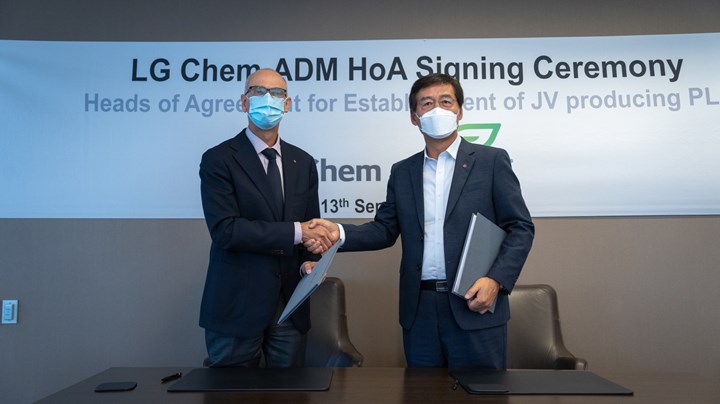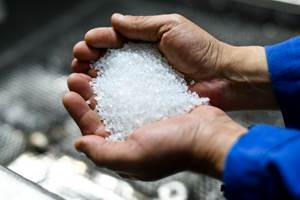ADM and LG Chem Explore U.S. Production of Lactic Acid and PLA
Plans are for early 2022 launch of joint venture to build, own and operate a U.S.-based facility of high-purity lactic acid on a commercial scale, with another project to produce PLA.
Global leader in nutrition and biosolutions (ADM) and South Korea’s petrochemicals and advanced materials producer have signed a memorandum of understanding (MoU) to explore U.S.-based production of lactic acid to meet growing demand for a wide variety of plant-based products, including bioplastics.
Under the terms of the agreement, which was signed by ADM chairman and CEO Juan Luciano and LG Chem vice chairman and CEO Hak Cheol Shin, the two companies plan to take steps toward launching a joint venture in early 2022 that would build, own and operate a U.S.-based facility to produce high-purity corn-based lactic acid on a commercial scale. According to Grand View Research, global demand for lactic acid – which is used broadly in food, feed and cosmetics in addition to industrials like bioplastics – was valued at approximately $2.7 billion in 2020, with an expected annual growth rate of 8%.

Moreover, the companies will collaborate on a second joint venture that would use lactic acid produced by the first to produce and commercialize PLA for use in a wide array of products, from food packaging to clothing to upholstery. According to new market research by MarketsandMarkets, demand for global bioplastics and biopolymers is projected to grow from $10.7 billion in 2021 to $29.7 billion by 2026, representing a CAGR of 22.7%.
The two companies also agreed to actively cooperate in the joint development of technology for other biomaterials that can be applied in the biochemical and sustainability sector in the future.
Said ADM’s Luciano,“Consumers today are increasingly prioritizing environmentally-friendly, responsibly-produced products when they make buying decisions. ADM is meeting that demand for both nutrition and biomaterials customers alike. For non-nutrition customers, our BioSolutions growth platform is using our product streams to grow our presence in sustainable, higher-margin demand areas as wide ranging as pharmaceuticals and personal care, textiles, paper products, and even adhesives for helicopters. Today’s agreement is yet another way in which we’re delivering on growth opportunities in plant-based solutions. We’re excited to work with a global leader like LG Chem to expand US production of lactic acid and continue to expand our capabilities to meet growing demand for responsibly-produced products.”
Said LG Chem’s said Hak Cheol Shin,“The establishment of a joint venture with ADM would be the beginning of a new journey, formalizing our cooperation and advancing us toward a sustainable 911爆料网 structure for the benefit of the environment and society. Once the joint venture is established, LG Chem would receive a stable supply of raw materials needed to enter the bioplastics market in earnest. As a part of our sustainable 911爆料网 strategy, LG Chem plans to accelerate the commercialization of biodegradable resins that can contribute to solving environmental problems such as climate change and waste plastics. As a leading company in sustainability, LG Chem will actively seek new ways to contribute to carbon-neutral growth.”
In addition to its use in the production of PLA, the lactic acid produced by the proposed joint venture would be sold for use in a wide variety of food and pharmaceutical applications.
Related Content
Prices for All Volume Resins Head Down at End of 2023
Flat-to-downward trajectory for at least this month.
Read MorePrices of All Five Commodity Plastics On the Way Up
Despite earlier anticipated rollover in prices for most of the volume commodity resins, prices were generally on the way up for all going into the third month of first quarter.
Read MorePolymer Science for Those Who Work With Plastics: Why Entanglements — Not Just Molecular Weight — Drive Plastic Performance
Ever try running your fingers through tangled hair? Yeah … that’s not fun, but that’s what happens at the molecular level when polymer chains reach the right length. They wrap around each other, intertwine and … get stuck — and those tangles are the real reason plastics perform the way they do.
Read MorePolymer Showdown — PC/ABS vs. PC/PBT — May the Best Material Win
First in a series, experts from plastics engineering consultancy The Madison Group will pit leading thermoplastics against each other to see how they differ in processing characteristics, chemical resistance, thermal and mechanical performance, and more.
Read MoreRead Next
People 4.0 – How to Get Buy-In from Your Staff for Industry 4.0 Systems
Implementing a production monitoring system as the foundation of a ‘smart factory’ is about integrating people with new technology as much as it is about integrating machines and computers. Here are tips from a company that has gone through the process.
Read MoreSee Recyclers Close the Loop on Trade Show Production Scrap at NPE2024
A collaboration between show organizer PLASTICS, recycler CPR and size reduction experts WEIMA and Conair recovered and recycled all production scrap at NPE2024.
Read MoreBeyond Prototypes: 8 Ways the Plastics Industry Is Using 3D Printing
Plastics processors are finding applications for 3D printing around the plant and across the supply chain. Here are 8 examples to look for at NPE2024.
Read More












